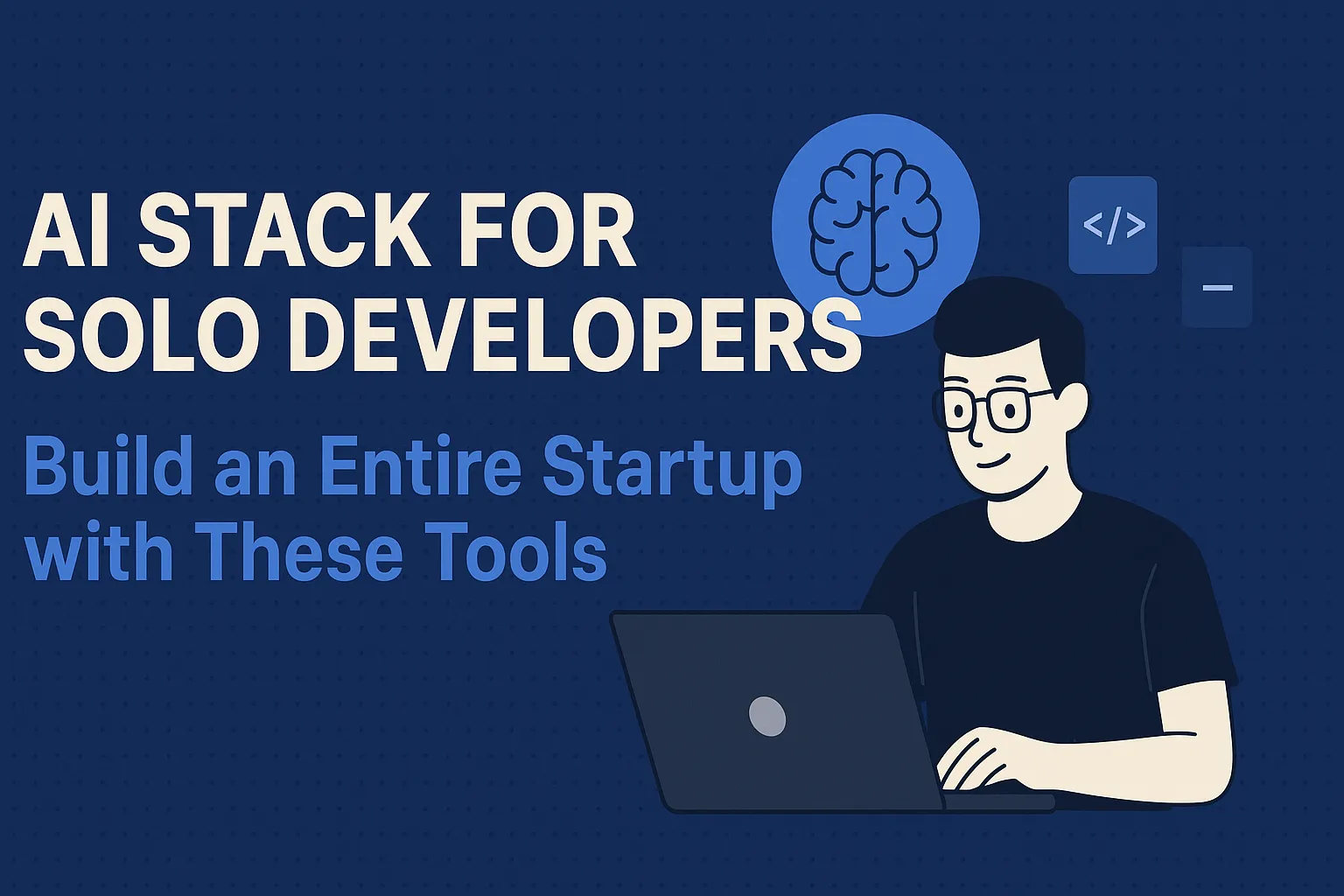AI Stack for Solo Developers: Build an Entire Startup with These Tools

Part of series
Code Less, Build More: AI-Powered DevelopmentIf you had told me five years ago that I could build a fully functional startup, design, backend, testing, and even deployment, entirely by myself, I’d have laughed really hard.
Back then, building and shipping something decent meant either grinding 18 hours a day or finding a small team to split the load. But today, the game has completely changed. With the right set of AI tools, most of which have free plans and a good dev strategy, you can move at the speed of a small funded startup team without the payroll, or the scheduling headaches.
I learned this the fun way by exploring some side projects with just my laptop, an internet connection, and a curiosity for every free AI tool I could get my hands on. The result was a fully working product, polished enough to launch publicly. And it was built in the amount of time it used to take me to finish a landing page.
In this post, I’ll share some of the AI platforms I used, covering frontend, backend, documentation, testing (probably), and launch, and how you can stitch them together to build your own startup from scratch. These aren’t “concept” tools or paywalled enterprise products, they are accessible, free (or with generous free tiers), and ready to help you ship faster than you thought possible.
Why an AI Stack Matters for Solo Developers
As a developer, you already know the drill. You can write code, debug, and deploy small projects. But the switch up from “side project” to “full-fledged startup” often feels like staring at a cliff without a rope or even an escalator. The code itself isn’t the problem, it’s everything else that's involved:
- Designing a UI that looks descent and user friendly.
- Writing clean documentation.
- Marketing and deploying.
- Literally every other thing.
When you’re a solo dev, your most valuable assets are time and focus, both of which are not entirely convenient to invest into projects you are not entirely sure of..
This is where a well-chosen AI stack changes the game. Instead of hiring a designer, a copywriter, a tester, and a DevOps engineer, you can use targeted AI tools to cover each of those roles just enough to ship without drowning in tasks.
Look around and you’ll see plenty of indie examples:
- A single developer building and selling niche SaaS tools with polished dashboards (thanks to AI-assisted UI generation).
- Small-scale web apps going from idea to launch in weeks because backend scaffolding and tests were generated by AI.
- Solo founders running online tools with thousands of users while keeping overhead near zero.
The key isn’t to let AI “do everything” for you, that’s a quick way to invite trouble and create unmaintainable code. Instead, think of it as a force multiplier, you still drive, but AI takes care of the slow, repetitive, or research-heavy parts so you can stay focused on building features that matter.
The AI Stack Breakdown
Over the past few months, I experimented with a couple of AI tools, and have come up with some that actually help solo developers ship faster without adding bloat. Here’s my recommended go-to stack.
3.1 Frontend
Tools: V0 by Vercel (free), shadcn/ui (free), React (free), Tailwind CSS (free).
If you’ve ever sat staring at a Figma file wondering how and where to start, V0 will feel like cheating. You type in a description, something as simple as “A responsive SaaS dashboard with a dark theme and a collapsible sidebar (or even mention your preferred stack like HTML and CSS)”, and V0 generates React + Tailwind code using the beautiful UI components.
Why I like it:
- The generated UI is already production-ready and accessible.
- You can export or tweak the code immediately or just ask V0 to do it for you.
- It’s faster than building from scratch without locking you into a rigid template.
Sample Prompt:
“Generate a React + Tailwind dashboard with a top navigation bar, sidebar navigation, and a main content area for analytics charts.”
Note: If you use JSX like me, V0 automatically writes any React code or component in TSX and sometimes stubbornly defaults back to TSX if you dont explicitly mention it in each following prompt.
3.2 Backend
Tools: ChatGPT Free (free tier for GPT-3.5), Claude.ai (free plan), Django (free), FastAPI (free), Node.js (free).
For backend logic, I mix Claude for precision and ChatGPT for handling longer code contexts (it can read and reason about multiple files at once). Whether you’re working with Django, FastAPI, or Node.js, both tools can help scaffold routes, models, authentication, and even database setup. Of course, V0 is great with backend code as well, but it's the best when it comes to UI, that's why it's not here.
Workflow Example:
- Use ChatGPT to plan and structure/setup your project.
- Paste your existing project structure into Claude to refactor or integrate new features without breaking things.
3.3 Documentation & Content
Tools: ChatGPT Free, Notion AI (free tier), Grammarly (free version).
Documentation isn’t glamorous, at all, but it’s essential. I use ChatGPT to create readable, structured docs, Notion AI to organize and polish them in my workspace, and Grammarly to catch tone or grammar slips before publishing. IF the AI you're using for the main backend code still has some context window or message capacity then you can ask it to write the documentation.
Workflow Example:
“Write a README for a Django project that includes user authentication, an admin dashboard, and a public API for the following code (paste code or upload file with structured code samples from your project). Include sections for installation, usage, and contributing.”
3.4 Testing
Tools: Codium AI (free plan), ChatGPT Free.
Testing is quite fun. Checking out your code and seeing that everything works, exquisite, and Codium AI makes it even more painless by generating unit tests based on your function logic. I then run those through ChatGPT to extend them into integration or end-to-end tests.
Workflow Example:
- Let Codium AI generate Python unit tests for your Django views.
Ask ChatGPT:
“Extend these tests to cover edge cases, including failed logins and expired sessions.”
3.5 Launch & Hosting
Tools: Vercel (free tier), Railway (free tier), Render (free tier).
When it’s time to launch, I keep it simple:
- Vercel for frontend hosting (React apps deploy in seconds via GitHub push).
- Railway or Render for backend APIs, both with built-in Postgres options on free tiers.
Workflow Example:
- Push your frontend repo to GitHub → connect to Vercel → deploy.
- Push your backend repo to GitHub → deploy to Railway/Render → connect your database.
This entire setup runs without touching AWS or complex CI/CD configs, perfect for solo devs who want to focus on features, not server tuning.
Building a Seamless Workflow
One thing I learned early on is that having great tools doesn’t matter if you’re constantly switching between tabs, rewriting prompts, and re-uploading the same files. That’s context-switch fatigue, and it’s the silent killer of solo developer productivity.
The trick is to chain your tools into a pipeline where each step flows naturally into the next. You don’t need enterprise-level automation, just a clear order of operations and minimal “mental gear changes.”
How I Connect the Stack
- Planning First with ChatGPT
- I have an extensive chat with my buddy ChatGPT and cover every aspect of my project that I am not sure about.
- I ask it to write a project description that includes all the plans we just discussed.
- Frontend Next with V0 + shadcn/ui
- I start with UI generation in V0 (free) so I can see what the product feels like early.
- Export the React + Tailwind code and drop it straight into my local dev environment.
- Backend Setup with ChatGPT & Claude
- Use ChatGPT to scaffold models, routes, and basic API endpoints.
- Hand over to Claude for integration work when the project spans multiple files or needs refactoring.
- Docs & Content in Parallel
- While coding, I have ChatGPT draft README sections.
- Polish and organize them in Notion AI (free tier).
- Testing as I Go with Codium AI
- Generate tests for new functions immediately after building them.
- Use ChatGPT to extend coverage and simulate real-world use cases.
- Deployment Without Delay
- Push frontend to GitHub → deploy instantly with Vercel.
- Push backend to GitHub → deploy on Railway or Render (free tiers).
Avoiding Context-Switch Fatigue
- Batch prompts: Instead of asking ChatGPT for one function at a time, ask for related features in a single request.
- Keep reference docs open: I keep shadcn/ui and Tailwind docs pinned so I don’t have to re-Google every class name.
- Limit tool switching: If a task can be done inside ChatGPT or Cursor without opening another site, I stick to it.
Final Thoughts
AI isn’t here to replace developers, it’s here to make the work a whole lot easier, faster, and more practical than ever. If you’ve got the skills to code and the discipline to ship, these tools can strip away the slow, repetitive parts and give you more time to focus on building what people actually want.
The biggest advantage is speed. You can validate an idea in days instead of weeks. Don’t overthink it. Start small, connect your tools, and let AI take care of the scaffolding while you focus on the creative and technical decisions that actually move your product forward.
If this is your first time reading this series, check out the previous posts:
- Using ChatGPT and Claude for Full-Stack App Development
- Getting the Most Out of V0: AI UI Generation for Frontend Projects
And if you want more posts like this, along with hand-picked tools, tips, and workflows for solo developers, subscribe to the Kumotechs newsletter. I send out one email a week, and it’s always packed with actionable content you can actually use.
